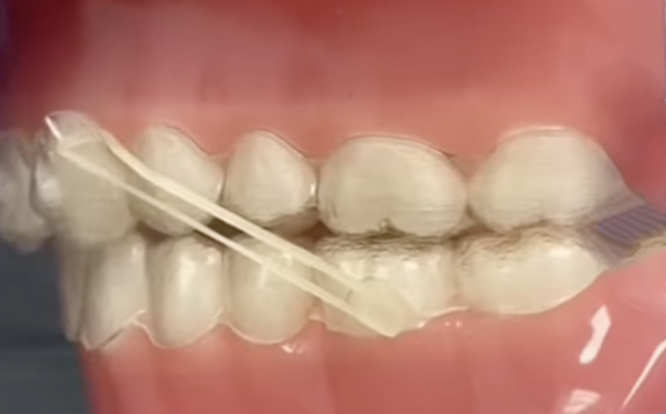Bronx, NY – Patients of all ages love Invisalign clear aligners. They are clear, removable, and comfortable. But some patients may have rubber bands prescribed as part of their treatment, even with Invisalign. How does this impact the discreet nature of the aligners?
“Elastics are sometimes a very necessary part of Invisalign treatment,” says Dr. Catherine Woo of Riverdale Family Orthodontics. “While not every patient will require them, for those that do, the elastics help us apply the forces needed to achieve the desired results. We find them especially helpful in correcting anterior posterior discrepancies and occlusion using clear aligners.”
So, what are these elastics and how will they impact your treatment?

The elastics are tiny rubber bands that will connect your top and bottom teeth via special hooks that will be built into the aligners or onto special attachments called buttons. We know that patients typically choose Invisalign as their treatment option because it’s more discreet that traditional braces. Elastics and attachments can make treatment more noticeable, but this depends on where they are placed and they are still the most discreet options on the market.
Attachments and Buttons: Enhancing Treatment Effectiveness
Attachments or buttons are made of bonding material that is placed on the teeth to help aligners move the teeth more predictably and also help attach the elastic bands. The material is the same color as your teeth so they won’t be as noticeable as traditional braces.
Elastics may be slightly more noticeable than the buttons depending on location and they will stretch while you are speaking. Rubber bands will attach from a spot on the top to a spot on the bottom. Choosing clear elastics will ensure your treatment stays as discreet as possible.
How Elastics Work and Their Importance
The elastics work by providing extra force to the aligners. This force will guide the teeth to their properly locations. They used to help improve bite alignment. You’ll wear your rubber bands many times as often as you wear your aligners, typically 22 hours a day. They will be removed to eat and drink, just as your aligners. You’ll need to replace the elastics with a new set at least once per day, or as directed by your orthodontist. Wearing the same set of elastics for too long will stretch the elastic and prevent it from properly doing its job.
“Not every patient will need elastics, but if you are prescribed them as part of your treatment plan, it’s important to wear them as directed,” says Dr. Woo. “We prescribe these elastics to ensure we can achieve your most ideal smile and bite. Wearing them properly and as often as directed will keep your treatment on track.”
Using Elastics: Tips and Precautions
While the elastics are simple to use, it can take a couple of days to get used to the process. You’ll place your aligners in your mouth first, and then you’ll hook the elastic in place over the first hook. Then, grasping the elastic with two fingers, you’ll stretch it to hook to the corresponding spot to ensure it is connect to the top and the bottom. A mirror can be helpful in the beginning, but after a few tries you’ll be able to place the elastics without even looking.
If a hook falls off and prevents you wearing elastics as directed at any point in your treatment, be sure to contact your orthodontist’s office right away to have it replaced. Continue to wear your aligners until you can get into our office though so your treatment doesn’t get set back.
Invisalign elastics can be an important part of your treatment plan. To learn more about Invisalign treatment and what it may entail for you, call Riverdale Family Orthodontics at 718-884-7700.


No Comments